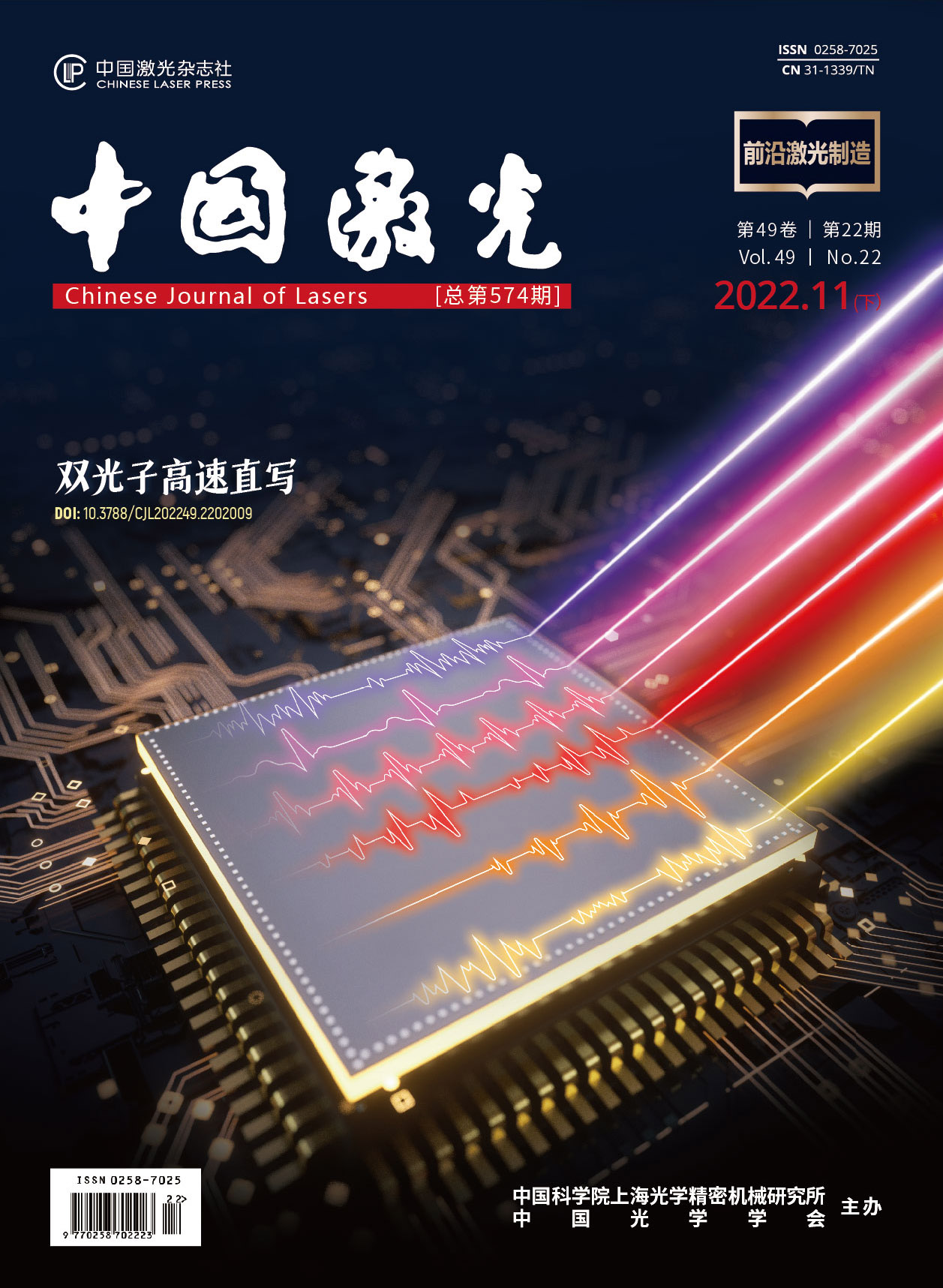高速并行双光子激光直写光刻系统  下载: 1072次封面文章
下载: 1072次封面文章
Recently, two-photon three-dimensional laser direct writing technology has realized fast development and gradually developed into a mature micro/nanofabrication technology. However, this technology is currently largely employed in laboratories. A limitation is the low direct writing speed. A simple and efficient approach to enhance the direct writing speed is to employ multibeam parallel writing instead of single beam writing. Some research has already employed a spatial light modulator or a diffractive optical element to produce multibeam parallel writing. However, till now, multibeam direct writing cannot be separately modulated for each channel, or the modulation speed is too slow, which has been unable to achieve a high-speed direct writing scheme with industrial application value. In addition, employing various motion scanning devices is also an effective means to improve the direct writing speed. In the previous work, piezoelectric stage is usually used for motion control. However, it can only attain a scanning speed of 0.1-10 mm/s. A faster, conventional solution is to employ a galvanometer, which can increase the speed by 1-2 orders of magnitude because of its low inertia. Recently, a study group employed the resonant galvanometer to achieve a higher scanning speed, up to 8 m/s, but the precision was low and the feature size was 1-4 μm. In this study, we design and verify a six-channel high-speed two-photon laser direct writing system, with a maximum direct writing speed of 7.770 m/s per channel, a feature size of 150 nm, and a comprehensive direct writing speed of 46.62 m/s in parallel writing.
In this research, we employ a 780 nm femtosecond laser as the light source and precompensate the group velocity dispersion using a grating pair module. The laser beam was modulated using a spacial light modulator to produce multiple beams. A weighted Gerchberg-Saxton algorithm is employed to create a six-beam hologram and produce a multibeam with high uniformity through continuous iteration. The multibeam is focused on a multichannel acoustic optical modulator (AOMC), to achieve high-speed independent modulation of the multibeam. Then the spot is imaged to a polygon laser scanner’s plane, which is employed to conduct the X-axis scan, and the 3D scanning is achieved using a linear stage with air bearings as Y-axis and a piezoelectric stage as Z-axis. Furthermore, a reflective image rotator is designed in this study (Fig. 3), which is positioned before the polygon laser scanner to adjust channel spacing continuously.
In this study, IP-dip two-photon photoresist made by Nanoscribe in Germany is employed as the standard photoresist sample. The first test was channel spacing uniformity. The distance between each adjacent channel is 8.7 μm [Fig. 4(a)], which is extremely close to the computed value of 8.75 μm. Compared with independently designing optical paths for each beam in the multibeam writing, employing SLM and AOMC to achieve the same function cannot only simplify the design but also has the benefit of high uniformity in channel spacing. The feature size measurement is the second test [Fig. 4(b)]. At the highest direct writing speed (~8 m/s), the line width decreases from 260.5 nm to 74.31 nm as the laser power decreases from 35 mW to 18 mW; however, after 150 nm, the lines start to form a lattice. The feature size of this system is approximately 150 nm, although a smaller feature size can be achieved by switching to a laser with a higher repetition frequency or employing low-speed direct writing. The third test was scanning speed [Fig. 4(d)]. In the single-channel mode, our maximum direct writing speed is 7.770 m/s and more than 46 m/s in six channels. The fourth test is to calibrate the image rotator [Fig. 4(c)]. The rotating stage’s precision employed in this system is 0.02°, according to equation (1), the adjustment accuracy of channel spacing is up to 0.3 nm. Additionally, this research performed the dot [Fig. 5(a)] and a programming test [Fig. 5(b)]. Table 1 compares the most recent literature studies on two-photon laser direct writing. In terms of scanning speed, our system obtains a speed of about 8 m/s at the single-channel mode, and in terms of feature size, our system reaches 150 nm, which is better than most studies.
In this study, SLM is employed to create six beams, and AOMC is employed to separately control the switching and intensity of each beam. High-speed writing is achieved based on a polygon laser scanner and two-dimensional linear stage with air bearings. The direct writing speed is 7.770 m/s in single-channel mode, and over 46 m/s at parallel writing. The feature size is approximately 150 nm. The system’s potential in high-speed writing was preliminarily confirmed. Furthermore, this system’s AOMC devices and laser energy serve as a limitation on the number of beams it can produce. It is easy to increase the number of beams by replacing more channel AOMC and higher power laser sources, therefore enhancing the writing’s effectiveness. However, there is still room for enhancement in the system’s writing strategy, which will be further investigated in the future. This study is of significant benefit in enhancing the writing speed of two-photon laser direct writing technology, which is helpful for the technology to advance toward greater industrial use.
王洪庆, 温积森, 杨臻垚, 汤孟博, 孙秋媛, 马程鹏, 王子昂, 詹兰馨, 张晓依, 曹春, 沈小明, 丁晨良, 匡翠方. 高速并行双光子激光直写光刻系统[J]. 中国激光, 2022, 49(22): 2202009. Hongqing Wang, Jisen Wen, Zhenyao Yang, Mengbo Tang, Qiuyuan Sun, Chengpeng Ma, Ziang Wang, Lanxin Zhan, Xiaoyi Zhang, Chun Cao, Xiaoming Shen, Chenliang Ding, Cuifang Kuang. High-Speed Parallel Two-Photon Laser Direct Writing Lithography System[J]. Chinese Journal of Lasers, 2022, 49(22): 2202009.







